- Health and hygiene, schools and other non-household settings
- Health issues and connections with sanitation
- SaniPath - Assessment of Fecal Exposure Pathways in Low-Income Urban Settings (Emory University, USA) - and appeal to SuSanA members for input
SaniPath - Assessment of Fecal Exposure Pathways in Low-Income Urban Settings (Emory University, USA) - and appeal to SuSanA members for input
33.7k views
- Elisabeth
-
- User is blocked
- Freelance consultant since 2012
Less- Posts: 3372
- Karma: 54
- Likes received: 932
Re: SaniPath - Assessment of Fecal Exposure Pathways in Low-Income Urban Settings (Emory University, USA) - and appeal to SuSanA members for input
I like to show the continuity of projects and discussion threads. For this reason, I am posting here a presentation from the
FSM5 conference
in Feb 2019 about Sanipath:
fsm5.susana.org/images/FSM_Conference_Ma...AKA-PRESENTATION.pdf
Evidence to action - Sanipath results
by Grace Mwanza Ndashe, EC. Mulwanda, N. Nan’gamba, C. Siesel, S. Raj, H. Yakubu, W. Mairinger, CL Moe, I. Nkhata
LUSAKA CITY COUNCIL
Two slides from the presentation:
Regards,
Elisabeth
fsm5.susana.org/images/FSM_Conference_Ma...AKA-PRESENTATION.pdf
Evidence to action - Sanipath results
by Grace Mwanza Ndashe, EC. Mulwanda, N. Nan’gamba, C. Siesel, S. Raj, H. Yakubu, W. Mairinger, CL Moe, I. Nkhata
LUSAKA CITY COUNCIL
Two slides from the presentation:
Regards,
Elisabeth
Dr. Elisabeth von Muench
Freelance consultant on environmental and climate projects
Freelance consultant on environmental and climate projects
Attachments:
-
 sanipath1.png
(Filesize: 118KB)
sanipath1.png
(Filesize: 118KB)
-
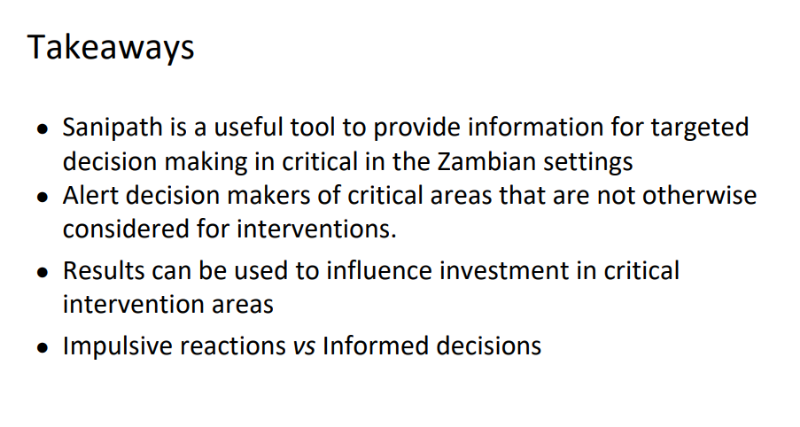 sanipath2.png
(Filesize: 135KB)
sanipath2.png
(Filesize: 135KB)
Please Log in to join the conversation.
You need to login to replyRe: SaniPath - Assessment of Fecal Exposure Pathways in Low-Income Urban Settings (Emory University, USA) - and appeal to SuSanA members for input
Hello Henriette,
I thought it may helpful to share some of the publications from our work in SaniPath Accra. You can find them below. Please do not hesitate to contact me if you have any questions.
Public toilets and their customers in low-income Accra, GhaAssessment of Fecal Exposure Pathways in Low-Income Urban Neighborhoods in Accra, Ghana: Rationale, Design, Methods, and Key Findings of the SaniPath Study
Quantifying Contact with the Environment: Behaviors of Young Children in Accra, Ghana
Public toilets and their customers in low-income Accra, Ghana
Quantification of exposure to fecal contamination in open drains in four neighborhoods in Accra, Ghana
Behavioral influences on risk of exposure to fecal contamination in low-resource neighborhoods in Accra, Ghana
I thought it may helpful to share some of the publications from our work in SaniPath Accra. You can find them below. Please do not hesitate to contact me if you have any questions.
Public toilets and their customers in low-income Accra, GhaAssessment of Fecal Exposure Pathways in Low-Income Urban Neighborhoods in Accra, Ghana: Rationale, Design, Methods, and Key Findings of the SaniPath Study
Quantifying Contact with the Environment: Behaviors of Young Children in Accra, Ghana
Public toilets and their customers in low-income Accra, Ghana
Quantification of exposure to fecal contamination in open drains in four neighborhoods in Accra, Ghana
Behavioral influences on risk of exposure to fecal contamination in low-resource neighborhoods in Accra, Ghana
Suraja Raj, MPH
Program Associate
Center for Global Safe Water
Rollins School of Public Health-Hubert Department of Global Health
Emory University
1518 Clifton Road, NE
MS: 002-7BB CNR 6040F
Atlanta, GA 30322
Tel:+001-404-727-5977
Program Associate
Center for Global Safe Water
Rollins School of Public Health-Hubert Department of Global Health
Emory University
1518 Clifton Road, NE
MS: 002-7BB CNR 6040F
Atlanta, GA 30322
Tel:+001-404-727-5977
Please Log in to join the conversation.
You need to login to replyRe: SaniPath - Assessment of Fecal Exposure Pathways in Low-Income Urban Settings (Emory University, USA) - and appeal to SuSanA members for input
Hi Elisabeth,
Thanks for your message! We have made several updates to the SaniPath Tool since our original post (including a new logo!). Most notably, we have updated the analysis methods for our tool so that we no longer use mean point estimates to estimate risk of exposure to fecal contamination, and now use the distribution of contamination and behavior in a Bayesian analysis. Additionally, we are in the process of updating our tool software to make it more user friendly.
Here’s a sneak peek of what you can expect in the new and improved SaniPath Exposure Assessment Tool.
Mobile Data Collection built on Open Data Kit
An online interface built on R Shiny that generates summary statistics and risk profile graphics.
Summary Statistics are shown as pie charts (for behavioral data) and histograms (for environmental sample data).
Risk profiles, below, shows the percentage of people exposed to fecal contamination per month and the dose of exposure (amount of E. coli ingested per month). The risk profile shows red people for those exposed to fecal contamination and gray for those unexposed; the darker the red, the higher the dose of exposure.
At this point the Sanipath Tool has been used in several different cities: Accra, Ghana; Vellore, India; Maputo, Mozambique; Siem Reap, Cambodia; and Dhaka, Bangladesh (ongoing). In addition, EAWAG used the Tool as a pilot in Tikapur, Nepal. We have several publications that have come out about both our larger SaniPath study work in Accra as well as in Vellore India.
Here is a list of SaniPath publications to date:
Public toilets and their customers in low-income Accra, GhaAssessment of Fecal Exposure Pathways in Low-Income Urban Neighborhoods in Accra, Ghana: Rationale, Design, Methods, and Key Findings of the SaniPath Study
Quantifying Contact with the Environment: Behaviors of Young Children in Accra, Ghana
Public toilets and their customers in low-income Accra, Ghana
Quantification of exposure to fecal contamination in open drains in four neighborhoods in Accra, Ghana
Behavioral influences on risk of exposure to fecal contamination in low-resource neighborhoods in Accra, Ghana
The Influence of Household- and Community-Level Sanitation and Fecal Sludge Management on Urban Fecal Contamination in Households and Drains and Enteric Infection in Children
Household sanitation is associated with lower risk of bacterial and protozoal enteric infections, but not viral infections and diarrhoea, in a cohort study in a low-income urban neighbourhood in Vellore, India
Thank you,
Suraja
Thanks for your message! We have made several updates to the SaniPath Tool since our original post (including a new logo!). Most notably, we have updated the analysis methods for our tool so that we no longer use mean point estimates to estimate risk of exposure to fecal contamination, and now use the distribution of contamination and behavior in a Bayesian analysis. Additionally, we are in the process of updating our tool software to make it more user friendly.
Here’s a sneak peek of what you can expect in the new and improved SaniPath Exposure Assessment Tool.
Mobile Data Collection built on Open Data Kit
An online interface built on R Shiny that generates summary statistics and risk profile graphics.
Summary Statistics are shown as pie charts (for behavioral data) and histograms (for environmental sample data).
Risk profiles, below, shows the percentage of people exposed to fecal contamination per month and the dose of exposure (amount of E. coli ingested per month). The risk profile shows red people for those exposed to fecal contamination and gray for those unexposed; the darker the red, the higher the dose of exposure.
At this point the Sanipath Tool has been used in several different cities: Accra, Ghana; Vellore, India; Maputo, Mozambique; Siem Reap, Cambodia; and Dhaka, Bangladesh (ongoing). In addition, EAWAG used the Tool as a pilot in Tikapur, Nepal. We have several publications that have come out about both our larger SaniPath study work in Accra as well as in Vellore India.
Here is a list of SaniPath publications to date:
Public toilets and their customers in low-income Accra, GhaAssessment of Fecal Exposure Pathways in Low-Income Urban Neighborhoods in Accra, Ghana: Rationale, Design, Methods, and Key Findings of the SaniPath Study
Quantifying Contact with the Environment: Behaviors of Young Children in Accra, Ghana
Public toilets and their customers in low-income Accra, Ghana
Quantification of exposure to fecal contamination in open drains in four neighborhoods in Accra, Ghana
Behavioral influences on risk of exposure to fecal contamination in low-resource neighborhoods in Accra, Ghana
The Influence of Household- and Community-Level Sanitation and Fecal Sludge Management on Urban Fecal Contamination in Households and Drains and Enteric Infection in Children
Household sanitation is associated with lower risk of bacterial and protozoal enteric infections, but not viral infections and diarrhoea, in a cohort study in a low-income urban neighbourhood in Vellore, India
Thank you,
Suraja
Suraja Raj, MPH
Program Associate
Center for Global Safe Water
Rollins School of Public Health-Hubert Department of Global Health
Emory University
1518 Clifton Road, NE
MS: 002-7BB CNR 6040F
Atlanta, GA 30322
Tel:+001-404-727-5977
Program Associate
Center for Global Safe Water
Rollins School of Public Health-Hubert Department of Global Health
Emory University
1518 Clifton Road, NE
MS: 002-7BB CNR 6040F
Atlanta, GA 30322
Tel:+001-404-727-5977
Attachments:
-
 piped_water_adult.jpg
(Filesize: 39KB)
piped_water_adult.jpg
(Filesize: 39KB)
-
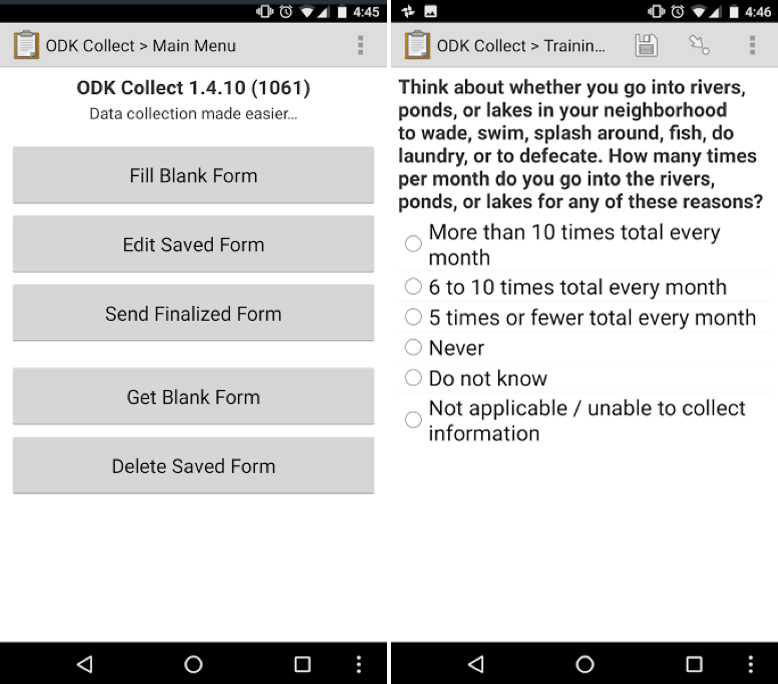 mobile_dat..._v02.jpg
(Filesize: 134KB)
mobile_dat..._v02.jpg
(Filesize: 134KB)
-
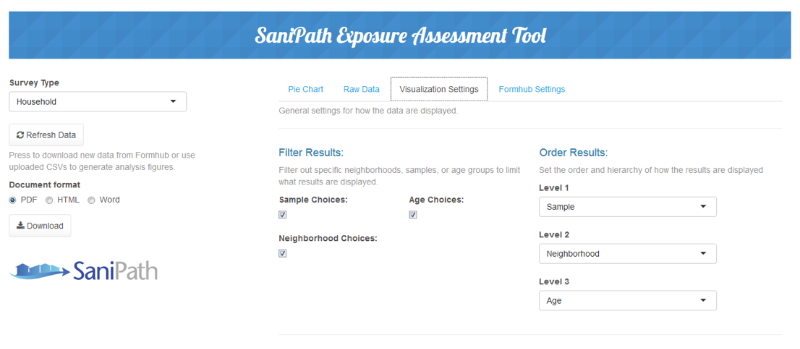 summary_st...file.png
(Filesize: 71KB)
summary_st...file.png
(Filesize: 71KB)
-
 piped_wate...osed.png
(Filesize: 77KB)
piped_wate...osed.png
(Filesize: 77KB)
-
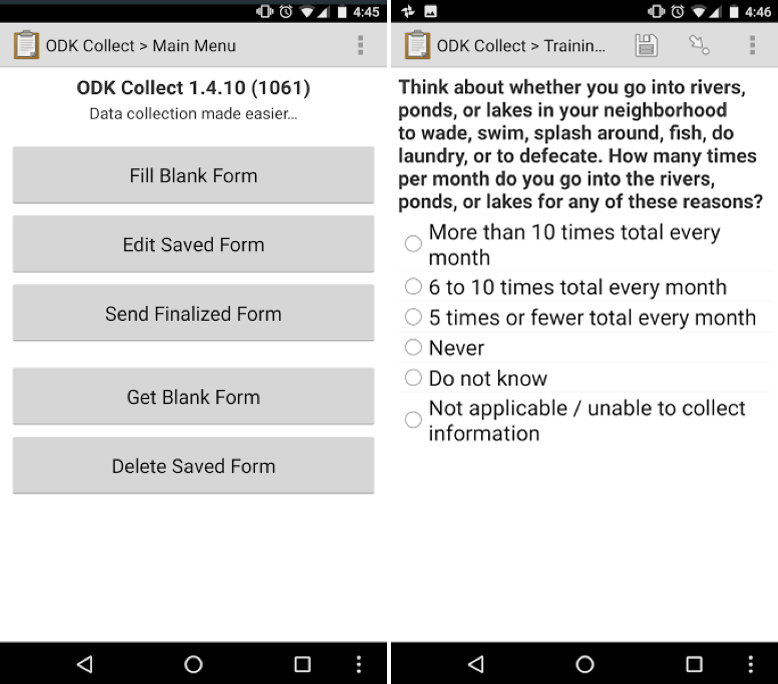 mobile_dat...7-21.jpg
(Filesize: 134KB)
mobile_dat...7-21.jpg
(Filesize: 134KB)
-
 piped_wate...7-21.png
(Filesize: 77KB)
piped_wate...7-21.png
(Filesize: 77KB)
-
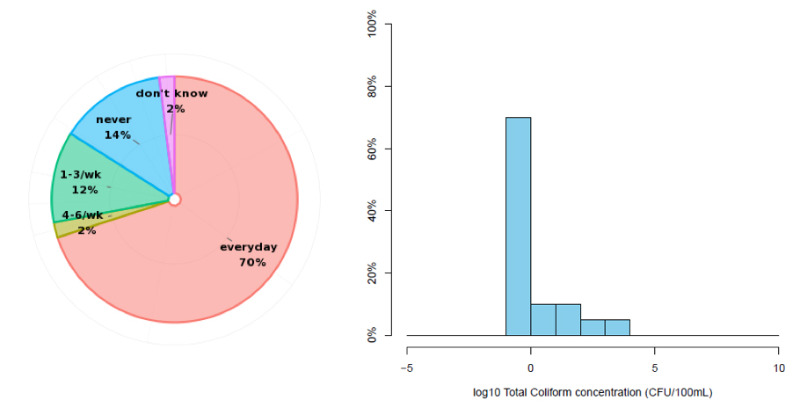 piped_wate...7-21.jpg
(Filesize: 39KB)
piped_wate...7-21.jpg
(Filesize: 39KB)
-
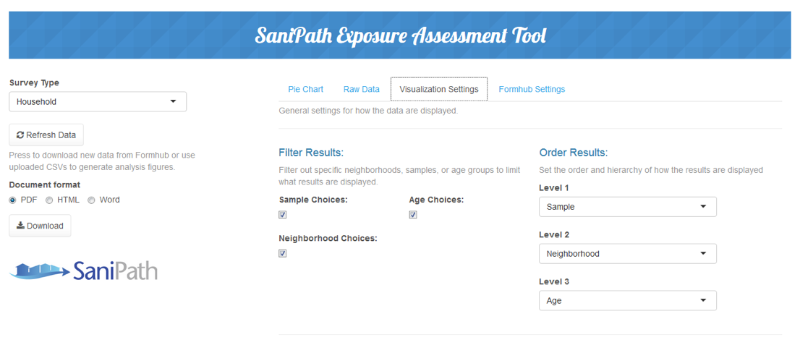 summary_st...7-21.png
(Filesize: 71KB)
summary_st...7-21.png
(Filesize: 71KB)
-
 CMYK-horiz.jpg
(Filesize: 233KB)
CMYK-horiz.jpg
(Filesize: 233KB)
Please Log in to join the conversation.
You need to login to reply- ECOlaTRINE
-
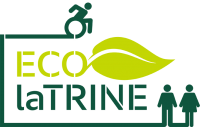
- By addressing water challenges - sanitation should be the first step.
Less- Posts: 22
- Karma: 1
- Likes received: 5
Re: SaniPath - Assessment of Fecal Exposure Pathways in Low-Income Urban Settings (Emory University, USA) - and appeal to SuSanA members for input
Dear Suraja
Thank you very much for your reply. I will go through the MapSan study document and will get back to you. Sub-Saharan countries have the same, or similar challenges. Recent droughts - experience in various SS countries just escalated the situation
Regards
Henriette.
Thank you very much for your reply. I will go through the MapSan study document and will get back to you. Sub-Saharan countries have the same, or similar challenges. Recent droughts - experience in various SS countries just escalated the situation
Regards
Henriette.
Please Log in to join the conversation.
You need to login to replyRe: SaniPath - Assessment of Fecal Exposure Pathways in Low-Income Urban Settings (Emory University, USA) - and appeal to SuSanA members for input
Hello!
Thank you for your interest in our study. Of the top of my head, I am not currently aware of similar studies happening in South Africa, though I will let you know if any come across my desk. The SaniPath Tool has currently been used in Accra, Ghana; Vellore, India; Maputo, Mozambique; Siem Reap, Cambodia; and Dhaka, Bangladesh (ongoing). I am happy to point you to publications form Accra, if that would be helpful to you.
You may also be interested in the MapSan study in Maputo, Mozambique that is being carried out by colleagues at Georgia Tech and LSHTM. The project description can be found here: www.susana.org/en/resources/projects/details/284
The MapSan team are evaluating health effects of decentralised (non-piped) sanitation in an informal urban setting. We collaborated with them on some SaniPath work in Maputo (the results of which are not yet finalized).
Best,
Suraja
Thank you for your interest in our study. Of the top of my head, I am not currently aware of similar studies happening in South Africa, though I will let you know if any come across my desk. The SaniPath Tool has currently been used in Accra, Ghana; Vellore, India; Maputo, Mozambique; Siem Reap, Cambodia; and Dhaka, Bangladesh (ongoing). I am happy to point you to publications form Accra, if that would be helpful to you.
You may also be interested in the MapSan study in Maputo, Mozambique that is being carried out by colleagues at Georgia Tech and LSHTM. The project description can be found here: www.susana.org/en/resources/projects/details/284
The MapSan team are evaluating health effects of decentralised (non-piped) sanitation in an informal urban setting. We collaborated with them on some SaniPath work in Maputo (the results of which are not yet finalized).
Best,
Suraja
Suraja Raj, MPH
Program Associate
Center for Global Safe Water
Rollins School of Public Health-Hubert Department of Global Health
Emory University
1518 Clifton Road, NE
MS: 002-7BB CNR 6040F
Atlanta, GA 30322
Tel:+001-404-727-5977
Program Associate
Center for Global Safe Water
Rollins School of Public Health-Hubert Department of Global Health
Emory University
1518 Clifton Road, NE
MS: 002-7BB CNR 6040F
Atlanta, GA 30322
Tel:+001-404-727-5977
Please Log in to join the conversation.
You need to login to reply- ECOlaTRINE
-

- By addressing water challenges - sanitation should be the first step.
Less- Posts: 22
- Karma: 1
- Likes received: 5
Re: SaniPath - Assessment of Fecal Exposure Pathways in Low-Income Urban Settings (Emory University, USA) - and appeal to SuSanA members for input
As I new to this field, it will be appreciated if you can advise me of similar studies currently taking place in South Africa. Rapid urbanization which leads to informal "shack dwelling" in, and around our cities - five corrugated zinc or wooded structures on one property without a supporting sanitation infrastructure. Please forward information about international conferences and workshops scheduled to take place in SA during 2017/18.
Please Log in to join the conversation.
You need to login to reply- Elisabeth
-
- User is blocked
- Freelance consultant since 2012
Less- Posts: 3372
- Karma: 54
- Likes received: 932
Re: SaniPath - Assessment of Fecal Exposure Pathways in Low-Income Urban Settings (Emory University, USA) - and appeal to SuSanA members for input
Dear Kate and SaniPath team!
One year on from your last post I am just wondering if you could update us with further developments regarding your SaniPath tool? For example, could you tell us more about this:
Furthermore, which are your current countries of interest? Is it still Ghana as you had indicated in your last post?
There is so much going on in Ghana regarding sanitation improvements, really encouraging to see .. (e.g. here on the forum lately about behavior change: forum.susana.org/5-community-led-approac...-question-from-ghana and about composting and reuse of fecal sludge: forum.susana.org/98-resource-recovery-fr...n-to-feed-the-nation )
Regards,
Elisabeth
One year on from your last post I am just wondering if you could update us with further developments regarding your SaniPath tool? For example, could you tell us more about this:
However, we do have plans to apply the tool in peri-urban areas and smaller towns where sanitation investments are planned through a partnership with EAWAG.
Furthermore, which are your current countries of interest? Is it still Ghana as you had indicated in your last post?
There is so much going on in Ghana regarding sanitation improvements, really encouraging to see .. (e.g. here on the forum lately about behavior change: forum.susana.org/5-community-led-approac...-question-from-ghana and about composting and reuse of fecal sludge: forum.susana.org/98-resource-recovery-fr...n-to-feed-the-nation )
Regards,
Elisabeth
Dr. Elisabeth von Muench
Freelance consultant on environmental and climate projects
Freelance consultant on environmental and climate projects
Please Log in to join the conversation.
You need to login to reply- karobb
-
Less
- Posts: 2
- Likes received: 0
Re: SaniPath - Assessment of Fecal Exposure Pathways in Low-Income Urban Settings (Emory University, USA) - and appeal to SuSanA members for input
Dear Sarah,
Thanks so much for your message and apologies on the delay in getting back to you!
Thanks for bringing up the important point regarding wastewater irrigation and health. One of the key findings from the in-depth SaniPath study in Accra was that the dominant pathway of exposure to fecal contamination for young children was through the food supply. This has important implications for the WASH sector – that typically ignores food safety. As you point out, urban agriculture is a key contributor to the food supply in many cities, and wastewater irrigation is a common practice. Our study demonstrates that this pathway for exposure combines high frequency of exposure and high “doses” of fecal contamination – making it a high-risk pathway that should be a priority for intervention. We’ve recently submitted a manuscript by Wang et al. detailing this finding to the American Journal of Tropical Medicine and Hygiene and we can send you a copy once it’s published. We also conducted a sub-study lead by a PhD student at the London School of Hygiene and Tropical Medicine, Prince Antwi-Agyei. The results of that work can be found in a journal article entitled “A Farm to Fork Risk Assessment for the Use of Wastewater in Agriculture in Accra, Ghana” (journals.plos.org/plosone/article?id=10....journal.pone.0142346).
Regarding your question about applying SaniPath in rural or peri-urban areas, we’ve put some thought into this in the past but don’t currently have plans to develop a version of the tool for rural areas. However, we do have plans to apply the tool in peri-urban areas and smaller towns where sanitation investments are planned through a partnership with EAWAG.
We've also recently circulated a policy brief on public toilets based the SaniPath study in Accra, Ghana (sanipath.org/wp-content/uploads/2016/04/...rin-Policy-Brief.pdf) that may be of interest.
We really value you taking the time to contact us and for sharing your insights! Please do keep in touch!
Kate
Katharine Robb, MPH
Associate Director, Research Projects
The Center for Global Safe WASH
Emory University
This email address is being protected from spambots. You need JavaScript enabled to view it.
Thanks so much for your message and apologies on the delay in getting back to you!
Thanks for bringing up the important point regarding wastewater irrigation and health. One of the key findings from the in-depth SaniPath study in Accra was that the dominant pathway of exposure to fecal contamination for young children was through the food supply. This has important implications for the WASH sector – that typically ignores food safety. As you point out, urban agriculture is a key contributor to the food supply in many cities, and wastewater irrigation is a common practice. Our study demonstrates that this pathway for exposure combines high frequency of exposure and high “doses” of fecal contamination – making it a high-risk pathway that should be a priority for intervention. We’ve recently submitted a manuscript by Wang et al. detailing this finding to the American Journal of Tropical Medicine and Hygiene and we can send you a copy once it’s published. We also conducted a sub-study lead by a PhD student at the London School of Hygiene and Tropical Medicine, Prince Antwi-Agyei. The results of that work can be found in a journal article entitled “A Farm to Fork Risk Assessment for the Use of Wastewater in Agriculture in Accra, Ghana” (journals.plos.org/plosone/article?id=10....journal.pone.0142346).
Regarding your question about applying SaniPath in rural or peri-urban areas, we’ve put some thought into this in the past but don’t currently have plans to develop a version of the tool for rural areas. However, we do have plans to apply the tool in peri-urban areas and smaller towns where sanitation investments are planned through a partnership with EAWAG.
We've also recently circulated a policy brief on public toilets based the SaniPath study in Accra, Ghana (sanipath.org/wp-content/uploads/2016/04/...rin-Policy-Brief.pdf) that may be of interest.
We really value you taking the time to contact us and for sharing your insights! Please do keep in touch!
Kate
Katharine Robb, MPH
Associate Director, Research Projects
The Center for Global Safe WASH
Emory University
This email address is being protected from spambots. You need JavaScript enabled to view it.
Please Log in to join the conversation.
You need to login to reply- SDickin
-
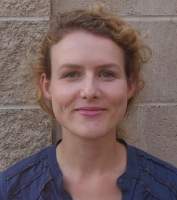
- User is blocked
- I'm a research fellow at the Stockholm Environment Institute and a geographer interested in environment health linkages, including how water and sanitation fit within the greater sustainable development agenda.
Less- Posts: 68
- Karma: 4
- Likes received: 26
Re: SaniPath - Assessment of Fecal Exposure Pathways in Low-Income Urban Settings (Emory University, USA) - and appeal to SuSanA members for input
Dear Sanipath team,
This is a really interesting project. I previously met Katherine at WWW but it is very helpful to learn more about all the different aspects of the work in this thread.
I recently reviewed research on wastewater irrigation and health risks (ehp.niehs.nih.gov/15-09995/), and one of the findings was that other exposure pathways (e.g. WASH, use of animal manure) were frequently ignored in these studies, which provides an incomplete picture. A gap it seems like SaniPath can address!
Another finding of this review was that there was little work examining different exposures during the farm to fork pathway. In the Sanipath case, I guess that only the end-product 'produce' would be assessed, but being able to compare farm level, transport/handling or marketplace contamination (washing of produce with contaminated water) could allow more targeted actions. Perhaps a targeted path could be developed to examine the greatest risk pathway in finer detail.
Do you see any potential for expanding beyond urban areas. During some research fieldwork in Uganda I observed that peri-urban or even 'rural'areas nearby towns were growing rapidly and poor planning of sanitation was occurring (and causing contamination of water resources with impacts on downsteam communities). It would be interesting to develop the tool to inform planning in areas that are rapidly growing like this.
best regards,
Sarah
This is a really interesting project. I previously met Katherine at WWW but it is very helpful to learn more about all the different aspects of the work in this thread.
I recently reviewed research on wastewater irrigation and health risks (ehp.niehs.nih.gov/15-09995/), and one of the findings was that other exposure pathways (e.g. WASH, use of animal manure) were frequently ignored in these studies, which provides an incomplete picture. A gap it seems like SaniPath can address!
Another finding of this review was that there was little work examining different exposures during the farm to fork pathway. In the Sanipath case, I guess that only the end-product 'produce' would be assessed, but being able to compare farm level, transport/handling or marketplace contamination (washing of produce with contaminated water) could allow more targeted actions. Perhaps a targeted path could be developed to examine the greatest risk pathway in finer detail.
Do you see any potential for expanding beyond urban areas. During some research fieldwork in Uganda I observed that peri-urban or even 'rural'areas nearby towns were growing rapidly and poor planning of sanitation was occurring (and causing contamination of water resources with impacts on downsteam communities). It would be interesting to develop the tool to inform planning in areas that are rapidly growing like this.
best regards,
Sarah
Dr. Sarah Dickin,
Research Fellow
Stockholm Environment Institute
Stockholm, Sweden
This email address is being protected from spambots. You need JavaScript enabled to view it.
Research Fellow
Stockholm Environment Institute
Stockholm, Sweden
This email address is being protected from spambots. You need JavaScript enabled to view it.
Please Log in to join the conversation.
You need to login to reply- Elisabeth
-
- User is blocked
- Freelance consultant since 2012
Less- Posts: 3372
- Karma: 54
- Likes received: 932
Re: Appeal to SuSanA members for input
Katharine's appeal from 24 August didn't lead to any responses yet, so I thought I would give you this additional background information:
Katharine presented about Sanipath, and about her appeal to SuSanA members, at the SuSanA meeting in September:
See here: www.susana.org/en/events/susana-meetings...na-meeting-stockholm
Using the Control+F function you will find her presentation:
Katharine Robb (Emory University): The SaniPath Rapid Assessment Tool:Assessing Public Health Risks from Unsafe Fecal Sludge Management in Poor Urban Neighborhoods
www.susana.org/images/documents/04-meeti...t_Tool_Session_4.pdf
See the video of her presentation here:
Or go to time 14:47 here:
Regards,
Elisabeth
Katharine presented about Sanipath, and about her appeal to SuSanA members, at the SuSanA meeting in September:
See here: www.susana.org/en/events/susana-meetings...na-meeting-stockholm
Using the Control+F function you will find her presentation:
Katharine Robb (Emory University): The SaniPath Rapid Assessment Tool:Assessing Public Health Risks from Unsafe Fecal Sludge Management in Poor Urban Neighborhoods
www.susana.org/images/documents/04-meeti...t_Tool_Session_4.pdf
See the video of her presentation here:
Or go to time 14:47 here:
Regards,
Elisabeth
Dr. Elisabeth von Muench
Freelance consultant on environmental and climate projects
Freelance consultant on environmental and climate projects
Please Log in to join the conversation.
You need to login to reply- karobb
-
Less
- Posts: 2
- Likes received: 0
Re: Appeal to SuSanA members for input
We'd like to make an appeal to Susana members for input on the following:
A. Suggestions about where we can deploy the SaniPath Rapid Assessment Tool?We're looking for 1) partners working at the city level interested in deploying tool to inform sanitation interventions, 2) partners who can use this type of data to inform their work, and 3) institutions that would be good candidates to learn to use the tool.
B. Suggestions for candidates for the advisory committee?
We're are in the process of assembling an international advisory committee that can provide input on the following questions:
1) What are the greatest challenges facing sanitation decision makers?
2) What scale are decision makers most interested in (city vs. neighborhood level)?
3) How can we best engage potential users of the tool?
4) How can we best convey risk results visually?
5) How can we facilitate the translation of the tool recommendations into actionable interventions.
We welcome and thank you for your input!
A. Suggestions about where we can deploy the SaniPath Rapid Assessment Tool?We're looking for 1) partners working at the city level interested in deploying tool to inform sanitation interventions, 2) partners who can use this type of data to inform their work, and 3) institutions that would be good candidates to learn to use the tool.
B. Suggestions for candidates for the advisory committee?
We're are in the process of assembling an international advisory committee that can provide input on the following questions:
1) What are the greatest challenges facing sanitation decision makers?
2) What scale are decision makers most interested in (city vs. neighborhood level)?
3) How can we best engage potential users of the tool?
4) How can we best convey risk results visually?
5) How can we facilitate the translation of the tool recommendations into actionable interventions.
We welcome and thank you for your input!
Please Log in to join the conversation.
You need to login to reply- YWAN446
-
Less
- Posts: 2
- Likes received: 1
Re: SaniPath - Assessment of Fecal Exposure Pathways in Low-Income Urban Settings (Emory University, USA)
Hi Joe,
I can explain in some more detail how the SaniPath analysis is planning to deal with the issue of sample variability.
The SaniPath study has three phases so far (Phase 1, Phase 1.5, and Phase 2). Right now we are working on a methodology to incorporate the variability from samples into our results. We have used phase 1 data, which has a larger sample size, to decide what types of distributions the environmental concentrations and frequencies of behavior follow. In order to see how robust a sample size of 10 was for each pathway, we used the bootstrap method and found that the variance of the mean of the log 10 concentrations for ten random samples was small. This enabled us to compare pathways on a log 10 scale. In order to prioritize pathways, we don't need an accurate estimate of the dose for each pathway, we just need the ranking. Since our goal is to distinguish 100 from 1000 rather than 20 from 50, ten samples are enough. Currently, we are conducting more analysis and trying to use a larger sample size for those pathways with a larger variability to increase the accuracy and robustness.
Furthermore, Bayesian Analysis (en.wikipedia.org/wiki/Bayesian_inference) can be used to estimate the distribution of both the environmental concentration and frequency of behavior, which account for variability. For example, if you sampled from the distribution and you had one accidentally highly contaminated sample while others were very clean, our new output could tell us that most of time this pathway is clean, but that there is a small probability that it could be very contaminated. This should be a good estimate of reality. If we sampled from the distribution again and we got ten samples that were all very clean, we could get results similar to the first time given the assumptions about the distribution. Though we didn't pick a highly contaminated sample the second time around, the distribution assumption can still inform us that there is a very small probability of getting a highly contaminated sample. Our results would depend on both the assumption of the distribution, which comes from our larger SaniPath phase 1 study, and the data people collect when they use the tool. I hope this helps answer your question about how our tool is trying to deal with chance variability.
Thanks,
Yuke (Andrew) Wang
Yuke Wang, MSPH
Data Analyst
Emory University
Rollins School of Public Health–Hubert Department of Global Health
Center for Global Safe Water
1518 Clifton Road, NE
MS: 002-7BB CNR6040B
Atlanta, GA 30322
Phone: 404-727-2238
Fax: 404-727-4590
I can explain in some more detail how the SaniPath analysis is planning to deal with the issue of sample variability.
The SaniPath study has three phases so far (Phase 1, Phase 1.5, and Phase 2). Right now we are working on a methodology to incorporate the variability from samples into our results. We have used phase 1 data, which has a larger sample size, to decide what types of distributions the environmental concentrations and frequencies of behavior follow. In order to see how robust a sample size of 10 was for each pathway, we used the bootstrap method and found that the variance of the mean of the log 10 concentrations for ten random samples was small. This enabled us to compare pathways on a log 10 scale. In order to prioritize pathways, we don't need an accurate estimate of the dose for each pathway, we just need the ranking. Since our goal is to distinguish 100 from 1000 rather than 20 from 50, ten samples are enough. Currently, we are conducting more analysis and trying to use a larger sample size for those pathways with a larger variability to increase the accuracy and robustness.
Furthermore, Bayesian Analysis (en.wikipedia.org/wiki/Bayesian_inference) can be used to estimate the distribution of both the environmental concentration and frequency of behavior, which account for variability. For example, if you sampled from the distribution and you had one accidentally highly contaminated sample while others were very clean, our new output could tell us that most of time this pathway is clean, but that there is a small probability that it could be very contaminated. This should be a good estimate of reality. If we sampled from the distribution again and we got ten samples that were all very clean, we could get results similar to the first time given the assumptions about the distribution. Though we didn't pick a highly contaminated sample the second time around, the distribution assumption can still inform us that there is a very small probability of getting a highly contaminated sample. Our results would depend on both the assumption of the distribution, which comes from our larger SaniPath phase 1 study, and the data people collect when they use the tool. I hope this helps answer your question about how our tool is trying to deal with chance variability.
Thanks,
Yuke (Andrew) Wang
Yuke Wang, MSPH
Data Analyst
Emory University
Rollins School of Public Health–Hubert Department of Global Health
Center for Global Safe Water
1518 Clifton Road, NE
MS: 002-7BB CNR6040B
Atlanta, GA 30322
Phone: 404-727-2238
Fax: 404-727-4590
The following user(s) like this post: evemackinnon7
Please Log in to join the conversation.
You need to login to reply
Share this thread:
- Health and hygiene, schools and other non-household settings
- Health issues and connections with sanitation
- SaniPath - Assessment of Fecal Exposure Pathways in Low-Income Urban Settings (Emory University, USA) - and appeal to SuSanA members for input
Recently active users. Who else has been active?
Time to create page: 0.309 seconds







